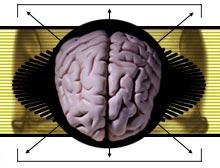Chip copies brain section responsible for memory, mood
Thursday, March 13, 2003 Posted: 10:20 AM EST (1520 GMT)
 |
| RELATED |
|
• Front of brain controls fear |
LONDON, England (Reuters) -- Scientists have developed the first artificial region of the brain -- a silicon chip that mimics an area that controls memory, mood and awareness.
Devised by researchers at the University of Southern California in Los Angeles, the chip is designed to carry on the functions of the region known as the hippocampus and could one day be used to help people with brain damage.
It will first be tested on tissue from rats' brains, and then on live animals.
"If all goes well, it will then be tested in a way to help people who have suffered brain damage due to stroke, epilepsy or Alzheimer's disease," New Scientist magazine said on Wednesday.
Theodore Berger and his team developed the artificial hippocampus as a test case to see if it could be done. It has taken them nearly 10 years.
First they devised a mathematical model of how the hippocampus performs under all conditions. The next step involved building the model into a silicon chip and then interfacing the chip with the brain in laboratory studies.
"No one understands how the hippocampus encodes information. So the team simply copied its behavior," according to the magazine.
If the initial brain tissue tests are successful, Berger and his colleagues plan to begin trials in live rats within six months and then in monkeys.
"If you lose your hippocampus you only lose the ability to store new memories," Berger told the magazine.
He added that if the chip, which will sit on the outside of the skull, helps someone with a damaged hippocampus regain the ability to store new memories it will be proof that it works.
But the magazine warned that because the device would affect memory and mood, which are fundamental to identity, it raises ethical and consent issues.
"If someone can't form new memories, then to what extent can they give consent to have this implant?" the magazine added.